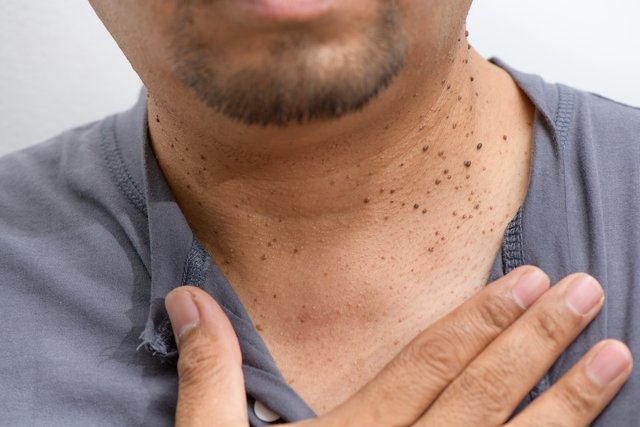Seborrheic keratosis is a benign skin lesion with a brown, black or light tan color, similar in appearance to a wart, which grows slowly and may appear on the head, neck, chest or back.
These lesions or tumors are caused by the benign proliferation of immature skin keratinocytes, which are cells present in the outer layer of the skin that provide protection, resistance and elasticity to the skin, being more common to occur in people over 50 years of age.
As it is a benign type of tumor, treatment is not normally recommended, only when it causes aesthetic discomfort or is inflamed, and the dermatologist may recommend cryotherapy or cauterization to remove it, for example.

Symptoms of seborrheic keratosis
The main symptom of seborrheic keratosis are skin lesions, which have characteristics such as:
- Coloring from brown to black, or light tan;
- Appearance similar to a wart;
- Round or oval shape with well-defined edges;
- Varied size, which can be small or large, measuring more than 2.5 cm in diameter;
- They can be flat or have a higher appearance.
These lesions can be single or multiple, and are not contagious, being more common to appear on the head, neck, chest, shoulders and back.
Although they are benign tumors, it is important to consult a dermatologist to confirm the diagnosis and differentiate them from other skin lesions, such as malignant melanoma.
How to confirm the diagnosis
The diagnosis of seborrhea keratosis is made by a dermatologist based on a physical examination and observation of skin lesions, mainly through a dermoscopy examination.
This examination allows the doctor to rule out other skin lesions that may have some similar characteristics, mainly malignant melanoma, lentigo maligna or melanocytic nevus, for example. Understand how the dermoscopy exam is performed.
Furthermore, if there is still doubt about the diagnosis, the doctor may request a biopsy of the skin lesion.
If you would like an evaluation with a dermatologist, schedule an appointment in the nearest region:
Taking care of your health has never been easier!
Possible causes
Seborrheic keratosis is caused by a benign proliferation of immature skin cells, keratinocytes, which produce keratin, responsible for skin protection, elasticity and resistance.
The exact cause of why this happens is not completely known, however, it appears to be related to genetic factors, as it appears more frequently in people who have family members with this skin change, are frequently exposed to the sun and are over 50 years.
Furthermore, people with darker skin are also more predisposed to the appearance of seborrheic keratosis, which is seen mainly on the cheeks, receiving the name dermatosis papulosa nigra. Understand what dermatosis papulosa nigra is and how to identify it.
How the treatment is carried out
As seborrheic keratosis is most often normal and does not pose a risk to the person, it is not necessary to initiate specific treatment.
However, the dermatologist may recommend carrying out some procedures to remove seborrheic keratosis when it itches, hurts, is inflamed or causes aesthetic discomfort, and may be recommended:
- Cryotherapywhich consists of using liquid nitrogen to remove the lesion;
- Chemical cauterizationin which an acidic substance is applied to the lesion so that it can be removed;
- Electrotherapyin which an electrical current is applied to remove the keratosis.
When symptoms associated with seborrheic keratosis appear, the dermatologist usually recommends a biopsy to check whether there are any signs of malignant cells and, if so, the most appropriate treatment is recommended.
Bibliography
- GRECO, M. J.; BHUTTA, B. S. IN: STATPEARLS (INTERNET). TREASURE ISLAND (FL): STATPEARLS PUBLISHING. Seborrheic Keratosis. 2023. Available at: <https://www.ncbi.nlm.nih.gov/books/NBK545285/>. Accessed on May 5, 2023
- WOLLINA, U. Recent advances in managing and understanding seborrheic keratosis. F1000Res. 8. F1000 Faculty Rev-1520, 2019
- BARTHELMANN, S.; et al. Seborrheic keratosis. J Dtsch Dermatol Ges. 21. 3; 265-277, 2023
- BRAZILIAN SOCIETY OF DERMATOLOGY. Chemical cauterization. Available at: <https://www.sbd.org.br/dermatologia/pele/procedimentos/cauterizacao-quimica/2/>. Accessed on February 17, 2020
- BRAZILIAN SOCIETY OF DERMATOLOGY. Ceratose. Available at: <https://www.sbd.org.br/dermatologia/pele/doencas-e-problemas/ceratose/46/>. Accessed on February 17, 2020
- BRITISH ASSOCIATION OF DERMATOLOGISTS. Seborrhoeic keratoses. 2017. Disponível em: <http://www.bad.org.uk/shared/get-file.ashx?id=231&itemtype=document>. Acesso em 17 fev 2020
- YORADJIAN, Alessandra; CYMBALISTA, Natalia C.; PASCHOAL, Francisco M. Seborrheic keratose mimicking melanoma. Surg Cosmet Dermatol. Vol 3. 2 ed; 169-171, 2011

Sign up for our newsletter and stay up to date with exclusive news
that can transform your routine!
Warning: Undefined array key "title" in /home/storelat/public_html/wp-content/plugins/link-whisper-premium/templates/frontend/related-posts.php on line 12
Warning: Undefined array key "title_tag" in /home/storelat/public_html/wp-content/plugins/link-whisper-premium/templates/frontend/related-posts.php on line 13




